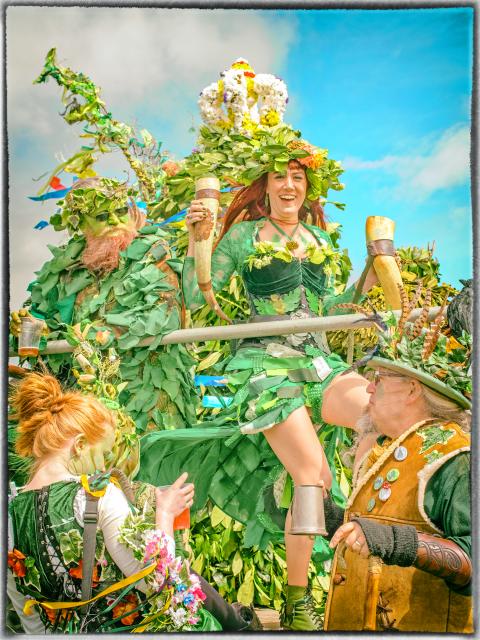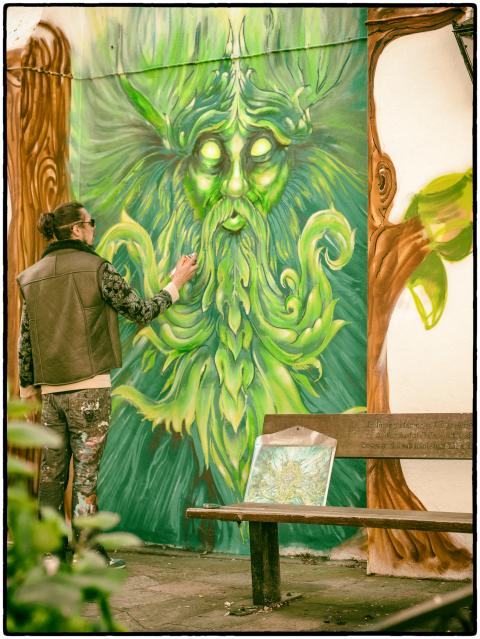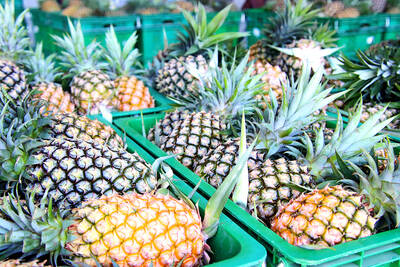A three-meter-tall structure decorated with twigs, leaves and branches, a green mask and a regal crown wends its way through the streets of Hastings Old Town. Somewhere inside is a weary man or woman — they take turns over the course of the parade — laboring under the weight of the edifice mounted on their shoulders. This is the “Jack-in-the-Green,” and it is followed by a retinue of revelers in pagan garb, sometimes jovial, often outlandish, predominantly green, always related in some way to Nature and the coming of the summer.
The day is May 1, the town is Hastings on the south coast of England, and the parade is part of the annual Jack-in-the-Green festival. In a few hours, Jack will be led onto a stage on the West Hill overlooking the old fishing harbor and seafront, and will be ceremoniously “slain,” releasing the spirit of summer. Everybody goes home with part of the dismantled greenery.
The May Day celebration in England goes back to Roman times. In the late 18th century, people would wear garlands of flowers and leaves, and in time work guilds would compete with each other for the most elaborate garlands. The Jack-in-the-Green figure evolved from the chimney sweeps’ guild, who made a garland so large it covered the entire person.

Photos: Paul Cooper, Taipei Times
照片:台北時報記者古德謙攝
The tradition went out of fashion by 1889, with the Victorians frowning upon on the noisy and drunken revelry that often accompanied the celebrations. It was revived in Hastings in 1983 by a group of Morris dancers.
(Paul Cooper, Taipei Times)
那是一個三尺高的東西,用樹葉和大大小小的樹枝裝飾著,還配戴著綠色的面具和一個皇冠,在哈斯汀古鎮沿街走著。這裡面有個疲憊的人,負著肩上的龐然巨物努力前進。一整趟遊行的路程要分好幾個人輪流背。這龐然巨物就是「綠人傑克」,後面跟著一群狂歡者,身穿異教服飾,幾乎清一色著綠衣。他們態度快活,又大多怪里怪氣,打扮讓人聯想到大自然及夏天的到來。

Photos: Paul Cooper, Taipei Times
照片:台北時報記者古德謙攝
這天是五月一日,在英格蘭南部海濱的哈斯汀鎮,這個遊行是一年一度的綠人傑克節。再過幾小時後,傑克就會被帶到西丘,從那裡可俯視整個漁港及濱海區,然後傑克就會在儀式中象徵性地被殺掉,以便將夏天的神靈釋放出來。活動結束後大家都會帶些拆卸下來的樹枝樹葉回家。
英國的五朔節活動可追溯至古羅馬時期。在十八世紀晚期,人們會戴上以花和葉子製成的花冠,而最後不同的公會之間會互相比賽誰的花冠做得最為精美。綠人傑克的造型是由掃煙囪公會的花冠演變而來的:他們把花冠做得超大,把整個人都蓋住了。
這個傳統在一八八九年就不流行了,因為這些慶祝活動常常伴隨吵鬧和醉醺醺的狂歡,令保守的維多利亞時代人相當看不慣。到了一九八三年,才由莫里斯舞者在哈斯汀所復興。

Photos: Paul Cooper, Taipei Times
照片:台北時報記者古德謙攝
(台北時報編譯林俐凱譯)

A: What types of fruit enzymes should we take to help reduce eye floaters? B: According to a study published in the “Applied Sciences” journal by Taiwanese ophthalmologist Horng Chi-ting, pineapple, papaya and fig supplements can improve symptoms. A: Pineapples are in season now, so you should munch on more of those to get rid of floaters. B: Not quite. Enzymes can be damaged by our stomach acid if we eat the fruit directly. The doctor says taking fruit enzyme capsules is better for absorption. A: Most importantly, we should reduce our use of personal electronics to prevent floaters from

Rice is essential to Japanese culture, tradition and politics. People take pride in the oval-shaped sticky Japonica grain, which is still a staple even though total consumption has fallen over the decades. But since last summer, prices have soared as supplies have fallen short of demand. The government has long paid farmers to cut back on rice acreage, and change to other crops to keep rice prices relatively high. To cope with shortfalls this year, the government has released rice reserves. But the grain has been slow to reach supermarket shelves. Anger over that was part of the reason the Agriculture Minister

In Taiwan, 7-Eleven convenience stores can be found on almost every street corner. With over 84,600 stores across 20 countries, 7-Eleven has more locations than any other retail business on Earth. For millions of people, the chain is an important part of daily life, providing coffee, quick meals, and essential items for those __1__. The history of 7-Eleven began nearly 100 years ago in Dallas, Texas. In 1927, the Southland Ice Company began selling blocks of ice that were used to keep fridges cool. Shortly after opening, the company __2__ its offerings to include groceries like milk, eggs, and

Continued from yesterday(延續自昨日) https://www.taipeitimes.com/News/lang In 1946, the company adopted the name 7-Eleven to reflect its newly extended __3__, from 7am to 11pm, a novel concept at the time. As a rapidly growing company, it began offering franchise opportunities in the 1960s. In 1974, the first 7-Eleven in Japan was opened by the supermarket company Ito-Yokado. The Japanese franchises were __4__ successful that by 1991, Ito-Yokado was able to acquire a 70 percent stake in Southland Corporation. Its investments eventually resulted in full ownership of 7-Eleven, which paved the way for the Japanese company to enter the international market. Since then, 7-Eleven